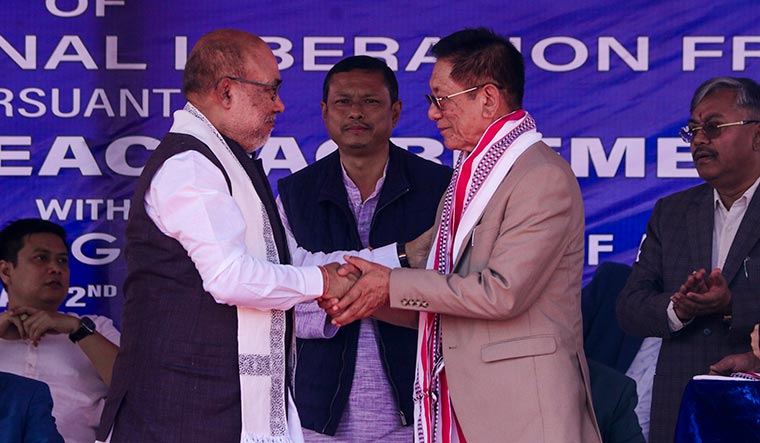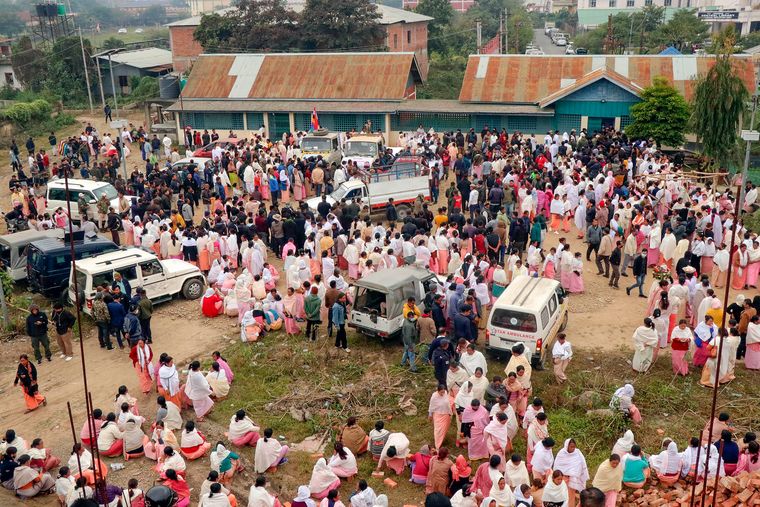As his cavalcade raced to Imphal’s Bir Tikendrajit International Airport on the morning of November 27, Manipur Chief Minister Nongthombam Biren Singh would have been in an upbeat mood.
Unlike in the past few months, when he often rushed to Delhi to defend his government’s efforts to stop the spiralling ethnic violence between Meiteis and Kukis, this time would be different, the 62-year-old would have thought.
There were two important tasks at hand.
The next day, he, along with Union Defence Minister Rajnath Singh, would unveil the crest of INS Imphal―India’s latest stealth-guided missile destroyer and an example of India’s increasing capability to make cutting-edge warships at home.
On the destroyer’s crest would be emblazoned the Kangla fort and the ‘Kangla-Sa’, or the mythical dragon-lion, which is also the state emblem. This would be the first time a warship was to be named after a city in the northeast.
The more critical event, however, would be the signing of a pact between the Centre, the state and the secessionist United National Liberation Front (Pambei) on November 29. Ever since he became chief minister in March 2017, Biren had been trying to get valley-based Meitei insurgent outfits to come to the negotiating table.
After the Basque nationalists’ Euskadi Ta Askatasuna (ETA) ceased operations five years ago in Spain, the Naga and Manipur underground movements would rank among the world’s longest-running insurgencies.
While many insurgent groups from Assam and Nagaland are involved in ongoing peace talks with the government, the major Meitei outfits had remained unyielding in their resolve to carry on with the armed struggle and to negotiate only if the issue of Manipur’s “sovereignty and independence” was taken up. In that sense, a pact with the UNLF, albeit a faction, is a significant event.
The volatile state has seen the birth of more than 42 insurgency outfits, mostly organised along ethnic lines; the state has over 33 ethnic communities. The Meiteis, about 15-lakh strong, make up about 58 per cent of the population. Meiteis are also the dominant community in the UNLF, as well as in the People’s Liberation Army, People’s Revolutionary Party of Kangleipak, Kangleipak Communist Party and Kanglei Yawol Kanna Lup.
The UNLF, among the biggest and most well-equipped outfits, has two factions. It is the Pambei faction, led by Khundongbam Lanjingba, that signed the peace agreement; the one led by Rajkumar Achou Singh ‘Koireng’―the stronger faction in terms of hardcore cadres and weapons―called the pact a “betrayal”.
Though there is no consensus on the cadre strength of the UNLF, most observers tracking insurgency in the northeast said that while the UNLF (Pambei) would have about 600 trained and armed cadres, the Koireng faction would have fewer. But, the latter are said to be more devoted to their cause. Many are believed to be in jungle camps in Myanmar.
“The attempt of the Indian government to sign the ‘peace talks agreement’ with the breakaway group of UNLF can only be described as ignorance of the dynamics of our national liberation struggle,” read a Koireng faction statement on December 2.
So, what prompted the Biren Singh government to hurry to close a deal with the UNLF? Like other BJP governments in the northeast, his, too, wants to make curbing insurgency and restoration of peace the USP of its rule. The recent Meitei-Kuki clashes shattered that aim. It was important to reverse that.
“A pact at this juncture will bring the narrative of the state government being successful at peace restoration to the forefront again,” said Kumar Sanjay Singh, a northeast observer and a history professor at Delhi University. “More so with parliamentary elections slated for next year. A positive spin had to be given.”
Moreover, there was a need to assuage the perceived ‘hurt’ within the majority Meitei community, which is the BJP’s main support base. There was a strong feeling among Meiteis that Delhi was favouring the Kukis during the violence. The Meiteis had openly accused the Assam Rifles of siding with the Kukis.
As for the UNLF(P), there were several reasons to ink a pact now. First, the reverberations of Myanmar’s Spring Revolution were being strongly felt among Manipur’s insurgent groups. Manipur, Arunachal Pradesh, Nagaland and Mizoram share a 1,643km porous border with Myanmar.
After the General Min Aung Hlaing-led military junta coup on February 1, 2021, the militias of the various pro-democracy groups had raised the banner of armed rebellion, with considerable success, against Myanmar’s military.
In particular, the recent success of ‘Operation 1027’ by the Three Brotherhood Alliance―Arakan Army, Ta’ang National Liberation Army and Myanmar National Democratic Alliance Army―has dented the efficacy and sustainability of the junta. Reports say the rebels have more territories under their control now than the ruling military.
“In all probability, UNLF(P) would not have entered into a ceasefire agreement with the government if there was no Spring Revolution in Myanmar,” said Rajeev Bhattacharyya, journalist and author of the recently released book ULFA: The Mirage of Dawn.
Bhattacharyya covertly visited Myanmar this year to study and gather information on the resistance movement against the junta-appointed State Administration Council. “During my assignment in Myanmar, I met and interviewed several resistance leaders and fighters from different communities who pointed fingers at some insurgent outfits from Manipur that were collaborating with the military in Myanmar against the opposition,” he said. “The [anti-military] operations [in Myanmar] have spread to... zones near the India-Myanmar border, where the military had establishments. The operation has also begun to target some of the junta’s allies that include groups from Manipur.”
Also, with the UNLF’s core area being a landlocked one, operational requirements mandated that they have safe camps in Myanmar. But the Meitei-Kuki clashes had restricted access to these safe camps. On December 4, a gunfight in a Kuki-dominated locality in Tengnoupal district killed 13 men believed to be members of the Meitei-dominated PLA. The site of the gunfight is about 30km from the Myanmar border.
“With no easy access to these safe havens in Myanmar, there was an operational requirement for some sort of a ceasefire with the government,” said Sanjay Singh. “The danger of the safe havens being cut off would be effectively suspended or neutralised by opening a chapter of negotiations.”
In concrete terms, the beginning of peace talks and a ceasefire only means cessation of hostilities till the duration of the negotiations.
Another factor that led to the pact is that politics has been slowly evolving in Manipur. A core UNLF demand has been that of a plebiscite, but of late, even civil society organisations have been talking openly of perhaps revisiting Manipur’s merger with the Indian Union and whether mainstream political parties have addressed Manipur’s interests. In that sense, the beginning of negotiations may be seen as a new avenue to carry out political discussions.
Also, the Meitei-Kuki clashes have shattered the social fabric of the multi-ethnic society in Manipur. This instilled some sort of ethnic identity consciousness among the Meitei insurgents. With more than 2,000 trained cadres of 24 Kuki insurgent outfits―which inked ‘suspension of operations’ pacts with the government―being allowed to reside in designated camps along with their weapons, a sense of vulnerability had crept into the Meiteis. It was felt that some Meitei outfits should also sign such pacts and be allowed to stay in designated camps along with their weapons if only to fight the Kukis.
“The possibility of more outfits inking ceasefire agreements with the government cannot be ruled out,” said Bhattacharyya.
However, the hurried pact could also be a cause for worry. Pacts with northeast’s insurgent organisations have a difficult history. While factions of the Naga underground and United Liberation Front of Asom (ULFA) are engaged in negotiations with the government, final resolutions have been elusive thus far.
The November 29 pact is also starkly reminiscent of the ‘framework agreement’ signed between the government and the National Socialist Council of Nagaland (Isak-Muivah) leadership on August 3, 2015. Though it was inked amid much fanfare with Prime Minister Narendra Modi and the Union Home Minister Amit Shah in attendance, a final resolution to the Naga issue is as distant as ever.
While the long-term implications of the UNLF(P) deal are in the realm of unpredictability, in the short term, it does serve the interests of both the Biren Singh government and the UNLF faction.



